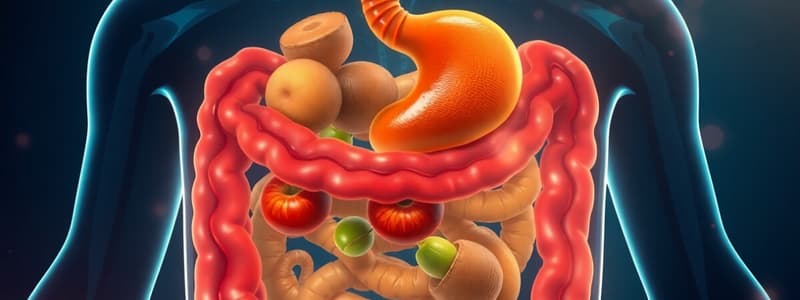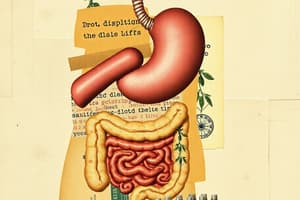Podcast
Questions and Answers
What is the process of taking in substances like food and drink into the body called?
What is the process of taking in substances like food and drink into the body called?
- Egestion
- Assimilation
- Ingestion (correct)
- Absorption
What is the primary function of digestion in the digestive system?
What is the primary function of digestion in the digestive system?
- To transport nutrients into the blood
- To remove undigested food from the body
- To break down large insoluble food molecules (correct)
- To store food for later use
Which mineral ion is specifically associated with the prevention of rickets?
Which mineral ion is specifically associated with the prevention of rickets?
- Calcium (correct)
- Sodium
- Potassium
- Iron
What describes the movement of nutrients from the intestines into the blood?
What describes the movement of nutrients from the intestines into the blood?
Which of the following organs is NOT part of the alimentary canal?
Which of the following organs is NOT part of the alimentary canal?
The removal of undigested food is known as which process?
The removal of undigested food is known as which process?
Which vitamin deficiency is directly related to scurvy?
Which vitamin deficiency is directly related to scurvy?
What is one primary function of teeth in the digestive process?
What is one primary function of teeth in the digestive process?
What is the primary role of maltase in digestion?
What is the primary role of maltase in digestion?
What role does saliva play in the digestion process?
What role does saliva play in the digestion process?
Which enzyme is responsible for breaking down starch into maltose in the mouth?
Which enzyme is responsible for breaking down starch into maltose in the mouth?
Which process is responsible for the breakdown of excess amino acids in the liver?
Which process is responsible for the breakdown of excess amino acids in the liver?
What action moves food through the esophagus?
What action moves food through the esophagus?
What is absorbed through the lacteal route during digestion?
What is absorbed through the lacteal route during digestion?
What is the function of hydrochloric acid in gastric juice?
What is the function of hydrochloric acid in gastric juice?
Which component of the large intestine is responsible for water absorption?
Which component of the large intestine is responsible for water absorption?
Which of the following statements accurately describes the differences between root hair cells and villi?
Which of the following statements accurately describes the differences between root hair cells and villi?
How does mucus function in the stomach?
How does mucus function in the stomach?
Which statement is true regarding pepsin?
Which statement is true regarding pepsin?
What is physical digestion primarily achieved by in the stomach?
What is physical digestion primarily achieved by in the stomach?
Which function does saliva NOT serve in the mouth?
Which function does saliva NOT serve in the mouth?
What is the primary role of pepsin in the stomach?
What is the primary role of pepsin in the stomach?
Why are proteases secreted in an inactive form?
Why are proteases secreted in an inactive form?
What is chyme?
What is chyme?
Which component of bile helps in the emulsification of fats?
Which component of bile helps in the emulsification of fats?
What function does the duodenum serve in the small intestine?
What function does the duodenum serve in the small intestine?
Which of the following correctly describes the pH change that occurs in the small intestine?
Which of the following correctly describes the pH change that occurs in the small intestine?
What is the role of hydrogen carbonate in the duodenum?
What is the role of hydrogen carbonate in the duodenum?
Which part of the small intestine is primarily responsible for the absorption of digested food?
Which part of the small intestine is primarily responsible for the absorption of digested food?
What happens to salivary amylase when it reaches the stomach?
What happens to salivary amylase when it reaches the stomach?
What is the primary purpose of bile pigment in bile?
What is the primary purpose of bile pigment in bile?
What is the primary function of amylase in pancreatic juice?
What is the primary function of amylase in pancreatic juice?
How does the structure of villi enhance nutrient absorption in the ileum?
How does the structure of villi enhance nutrient absorption in the ileum?
What is the role of bicarbonate in pancreatic juice?
What is the role of bicarbonate in pancreatic juice?
What is the primary function of lipase?
What is the primary function of lipase?
Why is the wall of vilis only one cell thick?
Why is the wall of vilis only one cell thick?
What type of nutrients are absorbed into the lacteals?
What type of nutrients are absorbed into the lacteals?
What is the length of the human ileum approximately?
What is the length of the human ileum approximately?
What is the role of peptidase in digestion?
What is the role of peptidase in digestion?
What adaptation in villi increases its surface area for absorption?
What adaptation in villi increases its surface area for absorption?
Which enzyme is primarily responsible for digesting carbohydrates?
Which enzyme is primarily responsible for digesting carbohydrates?
Flashcards
What is a balanced diet?
What is a balanced diet?
A balanced diet provides all the essential nutrients in the correct proportions to maintain good health, growth, and development.
What is the importance of carbohydrates?
What is the importance of carbohydrates?
Carbohydrates are the body's main energy source, providing fuel for physical activity and basic bodily functions.
What is the importance of fats and oils?
What is the importance of fats and oils?
Fats and oils provide essential fatty acids, energy storage, insulation for organs, and hormone production.
What is the importance of proteins?
What is the importance of proteins?
Signup and view all the flashcards
What is the importance of vitamins C and D?
What is the importance of vitamins C and D?
Signup and view all the flashcards
What is the importance of calcium and iron?
What is the importance of calcium and iron?
Signup and view all the flashcards
What is the importance of fiber?
What is the importance of fiber?
Signup and view all the flashcards
What is digestion?
What is digestion?
Signup and view all the flashcards
What is physical digestion?
What is physical digestion?
Signup and view all the flashcards
What is chemical digestion?
What is chemical digestion?
Signup and view all the flashcards
How do teeth aid digestion?
How do teeth aid digestion?
Signup and view all the flashcards
What is the role of saliva in digestion?
What is the role of saliva in digestion?
Signup and view all the flashcards
What does the esophagus do in digestion?
What does the esophagus do in digestion?
Signup and view all the flashcards
What happens in the stomach during digestion?
What happens in the stomach during digestion?
Signup and view all the flashcards
What is the role of pepsin in digestion?
What is the role of pepsin in digestion?
Signup and view all the flashcards
What is the purpose of mucus in the stomach?
What is the purpose of mucus in the stomach?
Signup and view all the flashcards
Stomach Mucus
Stomach Mucus
Signup and view all the flashcards
Pepsin
Pepsin
Signup and view all the flashcards
Trypsin
Trypsin
Signup and view all the flashcards
What are proteases?
What are proteases?
Signup and view all the flashcards
Why are proteases secreted in inactive forms?
Why are proteases secreted in inactive forms?
Signup and view all the flashcards
What is chyme?
What is chyme?
Signup and view all the flashcards
What is the duodenum?
What is the duodenum?
Signup and view all the flashcards
What is the ileum?
What is the ileum?
Signup and view all the flashcards
What is bile?
What is bile?
Signup and view all the flashcards
How do bile salts work?
How do bile salts work?
Signup and view all the flashcards
What is pancreatic juice?
What is pancreatic juice?
Signup and view all the flashcards
What is the function of bicarbonate in pancreatic juice?
What is the function of bicarbonate in pancreatic juice?
Signup and view all the flashcards
What does pancreatic amylase do?
What does pancreatic amylase do?
Signup and view all the flashcards
What does trypsin do?
What does trypsin do?
Signup and view all the flashcards
What does lipase do?
What does lipase do?
Signup and view all the flashcards
Where does pancreatic juice work?
Where does pancreatic juice work?
Signup and view all the flashcards
What are villi?
What are villi?
Signup and view all the flashcards
What are microvilli?
What are microvilli?
Signup and view all the flashcards
What are blood capillaries in the villi?
What are blood capillaries in the villi?
Signup and view all the flashcards
What does Maltase do?
What does Maltase do?
Signup and view all the flashcards
What is the hepatic portal vein?
What is the hepatic portal vein?
Signup and view all the flashcards
What are the main functions of the liver?
What are the main functions of the liver?
Signup and view all the flashcards
What is a lacteal?
What is a lacteal?
Signup and view all the flashcards
Study Notes
Human Nutrition
- Human nutrition encompasses the process of consuming and absorbing nutrients for growth, repair, and energy.
- A balanced diet includes carbohydrates, fats, proteins, vitamins (like C and D), minerals (like calcium and iron), fiber, and water.
- Key dietary sources of nutrients vary.
Digestive System
- The human digestive system encompasses organs like the mouth, esophagus, stomach, small intestine, large intestine, salivary glands, pancreas, liver, and gall bladder.
- These organs work in various stages of digestion
- Ingestion: Intake of food and drink.
- Digestion: Breaking down large food molecules into smaller, absorbable molecules.
- Absorption: Uptake of these smaller molecules into the bloodstream.
- Assimilation: Use of these absorbed molecules by body cells.
- Egestion: Removal of undigested food.
Digestion in Mouth
- Physical digestion involves mechanical breakdown of food through chewing by teeth.
- Chemical digestion in the mouth involves saliva.
- Saliva contains water, mucus, and amylase.
- Water helps dissolve food, mucus lubricates, while amylase initiates starch digestion.
Digestion in Stomach
- Physical digestion occurs through contractions of the stomach muscles.
- Chemical digestion involves gastric juice containing hydrochloric acid and pepsinogen.
- Hydrochloric acid kills bacteria, pepsinogen converts to pepsin to digest proteins.
- Mucus protects the stomach lining from acid.
Digestion in Small Intestine
- The small intestine comprises the duodenum and ileum.
- The duodenum receives bile from the liver and gallbladder, and pancreatic juice from the pancreas to further digest fats, proteins, and carbohydrates. – Bile: produced by liver, stored in gallbladder, emulsifies fats. – Pancreatic juice: contains enzymes to complete digestion of proteins, carbohydrates, and fats
- The ileum absorbs digested food molecules into the bloodstream via villi and lacteals, which are important for nutrient absorption
Intestinal Enzymes
- Intestinal enzymes include lipase, peptidase, and maltase, that work inside the intestines to breakdown fats, proteins and carbohydrates
Absorption
- Nutrients are absorbed into the blood or lymphatic system in the small intestine. – Blood: absorbs amino acids, monosaccharides etc – Lymphatic system: absorbs fats
Liver Function
- Liver performs various functions, including detoxification, protein synthesis, and glucose regulation.
Hepatic Portal Vein
- Connects intestines to liver
- Carries absorbed nutrients to liver
Hepatic Vein
- Carries blood away from the liver
- Carries substances from liver to heart and general circulation
Diseases
- Cholera: A bacterial infection causing severe diarrhea, caused by bacteria attached to the wall of the intestines and releasing toxins stimulating chloride ions which in turn increases the fluid in the lumen lowering water potential and causing osmosis
Studying That Suits You
Use AI to generate personalized quizzes and flashcards to suit your learning preferences.




